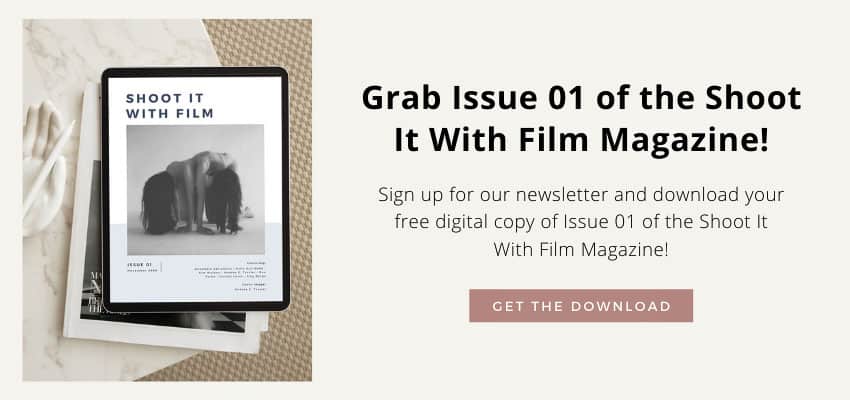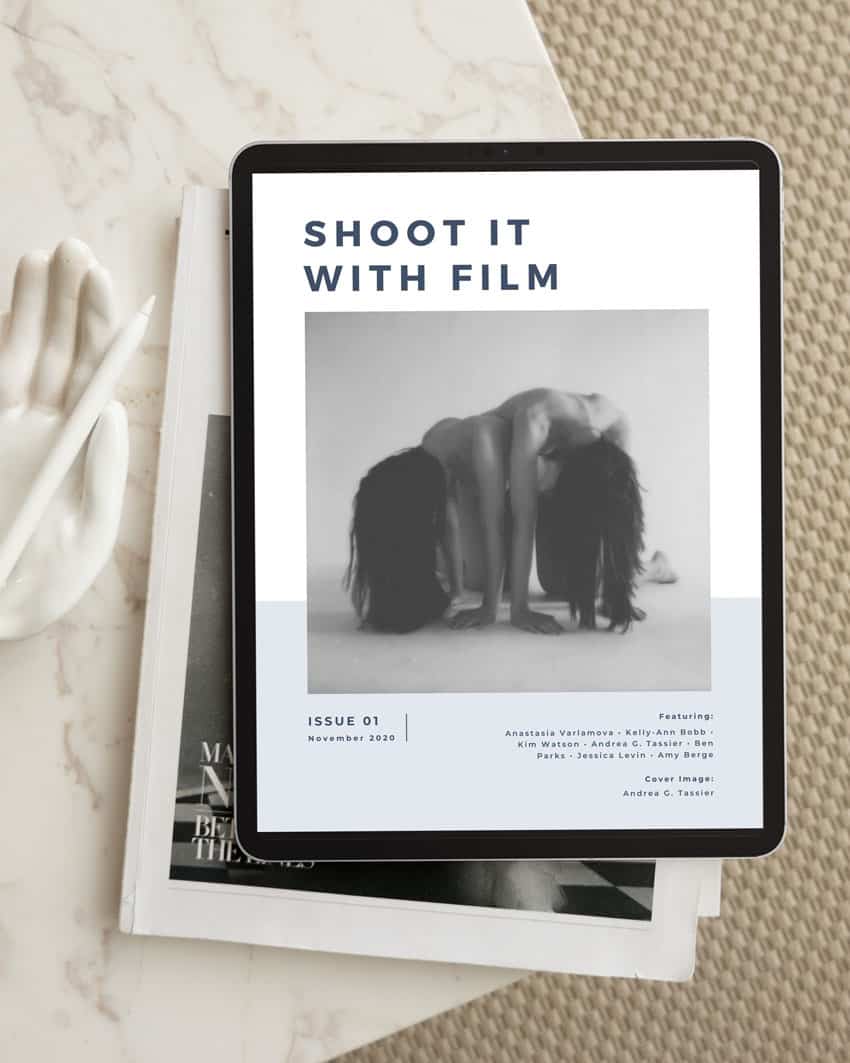How To Read A Number Shutter Speed Lightmeter On A 35mm Camera
This postal service may contain affiliate links. If you lot click on a link and brand a purchase, Shoot Information technology With Film may receive a small commission at no additional toll to you.
Written by Amy Elizabeth
This article is more of a PSA about rating and metering moving-picture show methods than a tutorial. But it's an issue I see lots of people fall victim to (including myself!), and then it's worth addressing and existence wary of.




A Quick Overview of Rating and Metering
First, what is rating and metering?
Rating is the ISO y'all set your camera or light meter to for a item moving-picture show stock. If you prepare your light meter to ISO 400, you are rating the film at 400.
Metering is the entire procedure of reading the light earlier you lot take an epitome and choosing the appropriate aperture and shutter speed settings for your camera. This is done with a handheld light meter or the light meter inside your camera.

So, What's the Issue?
Here'southward the situation: Someone online will inquire others how they charge per unit their film for a given stock. (Meaning the ISO they set their camera to for a detail film). And because the motion-picture show customs is extremely helpful, within a few minutes y'all'll get a dozen responses regarding how people exercise this.
"I always charge per unit my Fuji 400h at 100." or "Portras should be rated at box speed." etc.
And, yet, when we talk like this, nosotros're missing a major piece of data… how the photographer meters for light.
It'south like request someone what temperature to prepare the oven to for baking cookies without asking how long to bake them. 1 piece of information begs the answer to the other piece.
Ultimately, rating and metering work together as a ways to an end. That "end" being your aperture and shutter speed settings.
To get a full motion picture of how an prototype was captured on film, y'all demand to know how the prototype was metered besides as how it was rated.


The Many Variables in Metering Film
Unfortunately, finding out how someone metered their picture is not as simple as it sounds. At that place are and so many different factors when it comes to metering.
You can meter with a handheld light meter or with an in-camera light meter. You can meter bulb-in, bulb-out, in the highlights, or in the shadows. Y'all can use incident metering or reflective metering…this will all wildly affect your settings.
Metering is even more illusive in that fifty-fifty the angle you agree your meter will cause different results.

Testing Different Metering Scenarios
To see how unlike metering results at that place can exist in a given situation, I wanted to test how adjusting a few variables can alter the setting outputs.
The Shooting Setup
To gather some information, I took my son outside on what happened to exist a cloudy day and got to work.
Information technology was late afternoon and the clouds made the light look extremely flat. The divergence between the light on the side of his face towards the dominicus and the side of his face away from the sun looked relatively minor, so I was curious what the readings would show.
I placed him on the sidewalk so he was facing northward and the sun was in the southwest. The sun ended up being backside him and toward his left side, so I knew the left side of his face would be more than illuminated than the right.
The Metering Test with a Handheld Light Meter
Using my Sekonic 50-358 handheld light meter (observe the Fifty-358 at KEH Camera or on eBay), I fix the ISO to 400 for one test and 200 for the next test and set the aperture to a constant f/2.2. The meter reading would give me the resulting shutter speed.
Since there are about space ways to meter, I chose to consistently identify the bulb of my light meter about 45 degrees from the footing at his chin, and I metered the post-obit ways:
- Bulb-in (retracted) on the left side of his confront (the brighter side / in the highlights)
- Bulb-in on the correct side of his confront (the darker side / in the shadows)
- Bulb-out (protracted) in the highlights
- Bulb-out in the shadows
Here are the results with the shutter speed reading listed in cherry-red for metering in the shadows and green for metering in the highlights.

Comparing My Handheld Light Meter with My In-Camera Low-cal meter
I also took one last step and metered with my in-photographic camera calorie-free meter using reflective light off the grass. This is usually how I meter, so I was curious how information technology compared!.
Yous can watch my in-camera metering process here on my Instagram IGTV.
I typically meter for grass or something else that is similarly mid-toned in a shadowy area. (It's similar metering off of a grey carte, but using nature as your grey carte).
Since we are coming out of winter, our grass is extremely browny-yellowy, and so it's lighter than normal. I accounted for that by overexposing up to a stop from the meter reading I got.

It was cloudy, merely I found a spot that would be in the shadows if the sun was out (nether a tree) and metered off that. At ISO 400, I got a shutter speed of 1600, and, at ISO 200, a shutter speed of 800.
And since grass is lighter than normal, I would about likely account for that by overexposing a stop past shooting at a shutter speed of 800 for ISO 400 and 400 for ISO 200.
As you tin see in this detail instance, my in-camera meter reading was somewhere between bulb-in and bulb-out in the shadows, which fabricated me happy because it felt like information technology validated why I love the ease of an in-photographic camera meter for nigh situations.

Why This Makes the Rating Question then Tricky
I constitute it interesting that rating a film at 400 and metering bulb-out in the shadows would upshot in letting in a little more light than rating the film at 200 and metering bulb-in in the shadows.
So someone could insist that rating at 200 is the merely way to go, but they could potentially exist letting in LESS calorie-free than the person who rates their film at 400–depending on how the two people meter.
And all of this doesn't fifty-fifty business relationship for the different ways people hold their meter (45 degrees to the ground vs perpendicular to the ground). Or if the lord's day is out, resulting in greater discrepancies between highlights and shadows.
All this to say, when you discuss means to rate your flick, exist sure you're getting the full flick. And fifty-fifty more, this goes to show your shooting experience could be vastly different from someone else'south.

Video Demonstration for Metering Picture show
I ended upward eliciting my husband to video me on a sunny day with the meter so yous could run into how I'g metering for these readings. (Trying to pigment a full picture like I'm preaching, ya know?)
I was also curious how dissimilar the readings would be on a sunny solar day….and oh my goodness, the readings were extremely different.
The most marked deviation was between bulb-in and seedling-out in the highlights. This goes to testify yous that merely talking most metering without describing HOW yous meter is nigh worthless.

I besides metered in-camera and got 1/90th of a 2d for ISO 400.
I realize this is a weird reading…blame my Nikon n80 for its funny numbers. But that is very like to bulb-in in the shadows.
I would even overexpose upwards to a cease from there to account for the difference in the grass this time of yr compared to summer.

Final Thoughts
If you lot're new to film, hither's my word of communication (you might not like it, only I'thou going to say information technology anyhow): shoot ALL the moving-picture show ALL the means.
The merely way yous're going to know how you like to rate and meter your film will be to experiment and try different methods. Information technology will depend on how Y'all shoot (not how the famous photographer you lot follow shoots). Information technology will depend on how much contrast with punchy colors or muted with pastel colors you want in your photos.
And once you dial in a await you lot like, don't feel bad because you like to rate your Fuji 400h at 400 while your neighbor is telling y'all rating it at 100 is the Simply style to go. Your own personal trial and error will pb you where y'all need to be.

Thank you so much, Amy! Amy is a regular contributor here at Shoot It With Film, and you can check out her other manufactures here, including B&W Film Stock Comparison and How to Develop B&West Movie at Abode!
To see more of Amy'due south piece of work, be sure to visit her on her website and Instagram! Amy likewise shares tips and tutorials for shooting film over on her IGTV channel. Go check it out!
Leave your questions about rating and metering film below in the comments!

Source: https://shootitwithfilm.com/how-metering-and-rating-film-go-hand-in-hand/
Posted by: cooktheartumety.blogspot.com


0 Response to "How To Read A Number Shutter Speed Lightmeter On A 35mm Camera"
Post a Comment